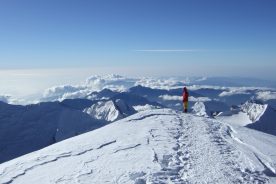Our grading system explained
What makes Nepal so special?
Why are holidays in Nepal so special and memorable?
For visitors to Nepal, trekking is still the biggest draw but the bustling city life and rich cultural traditions provide plenty to keep you occupied away from the mountains. What many visitors think will be their one trip of a lifetime all too often turns into a long-term love affair with this wonderful country and its people. Whether you want to go trekking in Nepal or tour the highlights of the country, Mountain Kingdoms will have the perfect holiday in for you.
The epic scale of the Everest and Annapurna mountain ranges naturally make these the two most popular regions for trekking in Nepal – some of these routes, such as the Everest Base Camp Trek and the Annapurna Circuit, are regarded as being among the best walks in the world. Venture further afield into ‘Wild Nepal’ and you will find pristine mountain scenery, remote villages and a culture still relatively untouched by tourism.
We also offer lots of exciting options for extending your time in Nepal from going on safari at Chitwan National Park to gentle rafting on the Seti River and from an indulgent stay in a stylish lodge near Pokhara to a tour of the cultural sights of the Kathmandu Valley.
Nepal Holidays, Walking and Trekking Tours
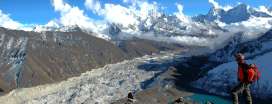
Nepal is the most exciting of the Himalayan nations, with the highest mountains and most vibrant culture, and has rightly been a favourite destination for travellers and trekkers for many years.
1 Holiday
- Our Mera Peak trek itinerary offers a carefully planned route with the best acclimatisation
- Stunning Himalayan scenery with close-up views of numerous Himalayan giants
- Highly experienced IFMGA qualified leader supported by Mera Peak climbing Sherpas in the ratio of 1 Sherpa to every 4 clients
- Tea house accommodation on the trail with two nights camping at Mera Peak
- Four star hotel in Kathmandu with time for rest and relaxation after your Mera Peak summit succes
Flight inclusive from £4695, Land only from £3395
- 1
Introduction
Nepal is perhaps the most exciting of the Himalayan nations with the highest mountains, most vibrant culture, and a friendly charm that has made it a favourite destination for travellers and trekkers for many years.
For the majority of travellers to Nepal trekking in the world’s great mountains is their primary objective but you don’t have to go far or particularly high to get a sense of the scenic, natural and cultural attractions of the country. Most Nepalese holidays start in the bustling capital of Kathamandu where Durbar square, Swayambanuth Temple and the tourist heartland of Thamel are among the main attractions. In the surrounding valley, the beautiful hilltop villages and World Heritage Sites of Patan and Bhaktapur can be explored on our Walking Holiday in Nepal holiday as well as on our in-depth Definitive Cultural Tour of Nepal.
If you want to get into the high mountains though, we can arrange Nepal trekking packages to most places in the country. The Annapurnas offer many different trekking opportunities from a gentle trekking holiday in the foothills, staying in luxury lodges, to a classic trek into the heart of the Annapurna Sanctuary or a short but immensely satisfying trek to Annapurna North Base Camp. Avoiding the crowds, you can trek across the high passes and remote valleys of the region with our Namun La, Naar Phu Circuit Trek or Grand Annapurna Traverse treks. All of which offer a real sense of wilderness.
In the Everest region, completing the trek to Everest Base Camp is the goal for most experienced trekkers, and there’s even an Everest Base Camp in Style trek for those who prefer a few home comforts on the trail. If you want to recreate the route of the original Everest pioneers then the Long Trek to Everest Base Camp might be just the Nepal expedition for you. For those looking to explore the Everest region beyond Base Camp there are several options. You can trek to the turquoise waters of the Gokyo Lakes, take the high altitude trek - the Three High Passes to Everest - or even challenge yourself on an Everest trekking peak such as Mera Peak. And if you can’t decide between Everest of Annapurnas, enjoy them both on our Annapurna & Everest in Style trek.
If you prefer a more remote experience, Wild Nepal will take you off-the-beaten-track. The little-explored area of Ganesh Himal, the majestic mountain vistas of Langtang, the mysterious landscapes of the Kingdom of Mustang, the remote base camps of Kangchenjunga and the traditional Tibetan culture of the Manaslu Circuit, all offer a different perspective on this beautiful and welcoming land.
Related articles:
The best places to visit in Nepal
Key Facts
- Capital city: Kathmandu
- Arrival airport: Kathmandu
- Population: 28,610,000 (2019 census)
- Area of country: 147,181 sq km
- Currency: Nepalese Rupee
- Time difference: GMT +5.75 hours
- Popular dishe/s: Dal bhat
- Popular drink/s: Chai tea and Raksi (an alcoholic homebrew)
- Power supply: 220v/240v
- Sockets: Round-three pin but can also be European or British variety sockets
- Official language: Nepali
- Religion: Hindu 80.6%, Buddhist 10.7%, Muslim 4.2%, Kirant 3.6%, other 0.9%
- Visa: British nationals require a visa to visit Nepal. This can be obtained in advance or on arrival
- Did you Know: The flag of Nepal is the only national flag in the world that is not quadilateral in shape
- FCDO link: FCDO travel advice for Nepal
Climate
When is the best time to travel to Nepal?
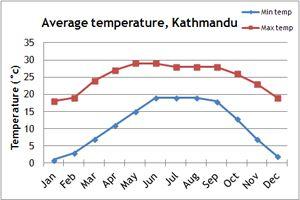
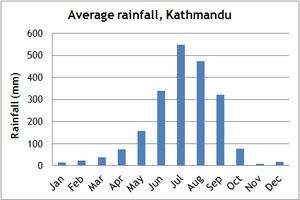
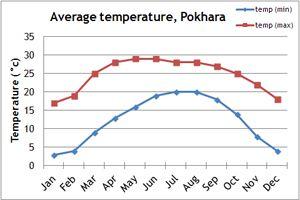
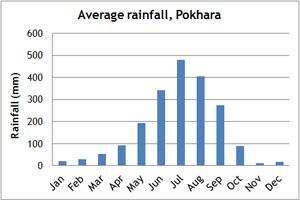
It is possible to travel to Nepal throughout much of the year, though for walking and trekking in Nepal, the best time to go is in spring (March-April) and autumn (October-November). Our temperature and rainfall charts will give you a guide to the climate in Nepal.
Autumn is thought to be the best time to visit Nepal. With dry weather and crisp, clear skies, the mountain views are at their best. The countryside is green and lush, following the summer monsoon. However, during this period the popular trails can be busy, and flights book up quickly, so do book in advance if you want to trek in Nepal during the autumn. We've introduced many treks which will get you off-the-beaten-path, and away from the crowds during this season.
In winter, the days are generally dry and bright, though at altitude the evenings will be extremely cold, and some high passes can be blocked by snow. Although a high-altitude trek may not be possible, winter can be a great time to visit Nepal, as there are fewer tourists. There are some fantastic walking and trekking holidays which are perfect for an adventurous winter holiday. You could spend Christmas day gazing at a perfect snowy mountain scene!
Between March and April, the weather warms up, and a whole range of trekking options are available. Skies may be more cloudy than in autumn, but the beautiful rhododendron and magnolia will be in bloom. Some of our holidays are timed to depart during the Easter period.
In summer, from June to August, the monsoon rains make a Nepal holiday a more challenging proposition. We consider that some destinations, such as Everest Base Camp, are unsuitable for trekking. Internal flight schedules can be affected and the mountain views are limited, even if the trails themselves are fine for trekking. Trekking in the Annapurna and Everest regions may not be possible, but Mustang and Dolpo, which lie in the rain shadow, make the perfect summer trekking destination.
If you would like to discuss your group or Tailor Made holiday to Nepal with one of our destination experts, then please call us on 01453 844400.
Frequently asked Questions
- Where is Nepal?
-
Bordered by Tibet to the north and India Nepal lies predominantly in the Himalaya. Its landscapes are surprisingly diverse rising from the flat, fertile plains of the Terai, through the picturesque foothills to the towering summits of the high Himalaya. It is home to eight of the world's ten highest mountains including, of course, Everest, the highest of them all at 8,848m.
- What is the best time to go to Nepal?
-
Apart from the monsoonal summer months, when getting around is difficult, you can visit Nepal at any time of the year. If you’re planning to trek, especially at higher altitude, then spring or autumn is the very best time to go to Nepal as the trails will be snow-free, the views clear and the weather warm, especially during the day. If you are planning on walking or touring in the Annapurna foothills or the Kathmandu Valley, then the winter months are also fine to travel, although January and February can be very chilly. For the wildlife-rich parks of Chitwan and Bardia, the optimum time to visit is between October and early March before the heat and humidity gets too high.
- Is Nepal tourist friendly?
-
Tourism is a mainstay of Nepal’s economy and very important to its people. You will always receive a warm welcome and generous hospitality, especially in the mountains, where the long-established tea house culture provides simple accommodation and hearty food for trekkers. We always recommend trekking with a guide as they know the trails back-to-front, understand the weather and natural conditions, and will make sure you are following good health and hygiene measures. They will also maximise your trekking experience through their excellent local knowledge. We include the services of an English-speaking guide on all our small group holidays. We also use good quality private vehicles for all road journeys in Nepal rather than public transport. This will give a good standard of comfort and safety when travelling between destinations in-country. Nepal’s main towns and cities are also very tourist friendly with low rates of crime, however you should of course exercise normal common-sense safety precautions when travelling to keep you and your belongings secure.
- Is Nepal a cheap country to visit?
-
Yes is the simple answer. The cost of food, drink, accommodation and other travel-related services compare very favourably to other destinations, especially if you are not looking for high-end, luxury options. Naturally prices are higher in the peak spring and autumn seasons so travelling a little out of season can reduce costs, particularly for international flights to Nepal. All of our group and tailor made holidays to Nepal include most meals, airport transfers, accommodation, private transport, a guide and support crew, and sightseeing (as per the individual itinerary). That means you only have to budget for a few meals in the cities, tips for your guide and other staff, and any souvenirs or treats for yourself. We give comprehensive advice on how much money you might need to take with in our pre-trip dossier of information, you’ll probably be surprised by how little you will actually spend.
- Is seven days enough for Nepal?
-
We don’t think so! If you only want to see Kathmandu and perhaps travel as far as Pokhara for some Himalayan mountain views, then a week might just be enough. But to even begin to explore further, you’ll need more time. Nepal has many attractions to tempt visitors from its incomparable mountain landscapes, to wildlife-rich parks, and from ancient Newari cities to important sacred sites. You can also do a wide range of adventurous activities such as trekking, mountaineering, cycling and river rafting plus more gentle walking in the lower hills or on-foot cultural tours. More time is absolutely essential if you’re planning on doing any trekking at altitude in the Everest region, the Annapurna mountains or beyond. This means having plenty of time to ascend slowly and including rest days to give your body time to adjust to the thinner air. To reach the Annapurna Sanctuay you’ll need to be on trek for at least 11 days in total and to make it to Everest Base Camp you should allow two weeks from start to finish of your trek. All of our trekking holidays are carefully designed to give excellent acclimatisation to minimise the risk of altitude sickness which can be very serious.





